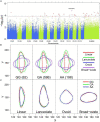Genetic Architecture of Heterophylly: Single and Multi-Leaf Genome-Wide Association Mapping in Populus euphratica
- PMID: 35783952
- PMCID: PMC9240601
- DOI: 10.3389/fpls.2022.870876
Genetic Architecture of Heterophylly: Single and Multi-Leaf Genome-Wide Association Mapping in Populus euphratica
Abstract
Heterophylly is an adaptive strategy used by some plants in response to environmental changes. Due to the lack of representative plants with typical heteromorphic leaves, little is known about the genetic architecture of heterophylly in plants and the genes underlying its control. Here, we investigated the genetic characteristics underlying changes in leaf shape based on the model species, Populus euphratica, which exhibits typical heterophylly. A set of 401,571 single-nucleotide polymorphisms (SNPs) derived from whole-genome sequencing of 860 genotypes were associated with nine leaf traits, which were related to descriptive and shape data using single- and multi-leaf genome-wide association studies (GWAS). Multi-leaf GWAS allows for a more comprehensive understanding of the genetic architecture of heterophylly by considering multiple leaves simultaneously. The single-leaf GWAS detected 140 significant SNPs, whereas the multi-leaf GWAS detected 200 SNP-trait associations. Markers were found across 19 chromosomes, and 21 unique genes were implicated in traits and serve as potential targets for selection. Our results provide novel insights into the genomic architecture of heterophylly, and provide candidate genes for breeding or engineering P. euphratica. Our observations also improve understanding of the intrinsic mechanisms of plant growth, evolution, and adaptation in response to climate change.
Keywords: Populus euphratica; genome-wide association study (GWAS); geometric morphometrics; heterophylly; leaf shape.
Copyright © 2022 Zhu, Sun, Sang, Ye, Bo, Dong and Wu.
Conflict of interest statement
The authors declare that the research was conducted in the absence of any commercial or financial relationships that could be construed as a potential conflict of interest.
Figures






Similar articles
-
Heterophylly Quantitative Trait Loci Respond to Salt Stress in the Desert Tree Populus euphratica.Front Plant Sci. 2021 Jul 15;12:692494. doi: 10.3389/fpls.2021.692494. eCollection 2021. Front Plant Sci. 2021. PMID: 34335660 Free PMC article.
-
Conjoint Analysis of Genome-Wide lncRNA and mRNA Expression of Heteromorphic Leavesin Response to Environmental Heterogeneityin Populus euphratica.Int J Mol Sci. 2019 Oct 17;20(20):5148. doi: 10.3390/ijms20205148. Int J Mol Sci. 2019. PMID: 31627402 Free PMC article.
-
Progress in studying heteromorphic leaves in Populus euphratica: leaf morphology, anatomical structure, development regulation and their ecological adaptation to arid environments.Plant Signal Behav. 2021 Apr 3;16(4):1870842. doi: 10.1080/15592324.2020.1870842. Epub 2021 Jan 11. Plant Signal Behav. 2021. PMID: 33427562 Free PMC article. Review.
-
The Identification and Characterization of the PeGRF Gene Family in Populus euphratica Oliv. Heteromorphic Leaves Provide a Theoretical Basis for the Functional Study of PeGRF9.Int J Mol Sci. 2024 Dec 25;26(1):66. doi: 10.3390/ijms26010066. Int J Mol Sci. 2024. PMID: 39795925 Free PMC article.
-
Heterophylly: Phenotypic Plasticity of Leaf Shape in Aquatic and Amphibious Plants.Plants (Basel). 2019 Oct 16;8(10):420. doi: 10.3390/plants8100420. Plants (Basel). 2019. PMID: 31623228 Free PMC article. Review.
Cited by
-
Genetic Variation Analysis and Development of KASP Marker for Leaf Area and Hight in Southern-Type Populus deltoides.Plants (Basel). 2025 Jan 23;14(3):330. doi: 10.3390/plants14030330. Plants (Basel). 2025. PMID: 39942892 Free PMC article.
-
Needle and Branch Trait Variation Analysis and Associated SNP Loci Mining in Larix olgensis.Int J Mol Sci. 2024 Sep 23;25(18):10212. doi: 10.3390/ijms251810212. Int J Mol Sci. 2024. PMID: 39337698 Free PMC article.
-
Integrating genome-wide association and transcriptome analysis to provide molecular insights into heterophylly and eco-adaptability in woody plants.Hortic Res. 2023 Nov 17;10(11):uhad212. doi: 10.1093/hr/uhad212. eCollection 2023 Nov. Hortic Res. 2023. PMID: 38046852 Free PMC article.
-
Selective sweep and GWAS provide insights into adaptive variation of Populus cathayana leaves.For Res (Fayettev). 2024 Apr 9;4:e012. doi: 10.48130/forres-0024-0009. eCollection 2024. For Res (Fayettev). 2024. PMID: 39524419 Free PMC article.
References
-
- Adams D. C., Rohlf F. J., Slice D. E. (2013). A field comes of age: geometric morphometrics in the 21st century. Hystrix 24:7.
-
- Ahmed A. A., Mohamed E. A., Hussein M. Y., Sallam A. (2021). Genomic regions associated with leaf wilting traits under drought stress in spring wheat at the seedling stage revealed by GWAS. Environ. Exp. Bot. 184:104393.
-
- Chai Y., Luo D., Yang J. (2012). Cytochrome P450 CYP78A5/KLUH participates in regulating phase transition of leaf development in Arabidopsis thaliana. Plant Physiol. Commun. 48 605–610.
-
- Chen H., Matthew P., Duy T. (2020). GMMAT: Generalized Linear Mixed Model Association Tests Version 1.3. Houston, TX.
LinkOut - more resources
Full Text Sources

